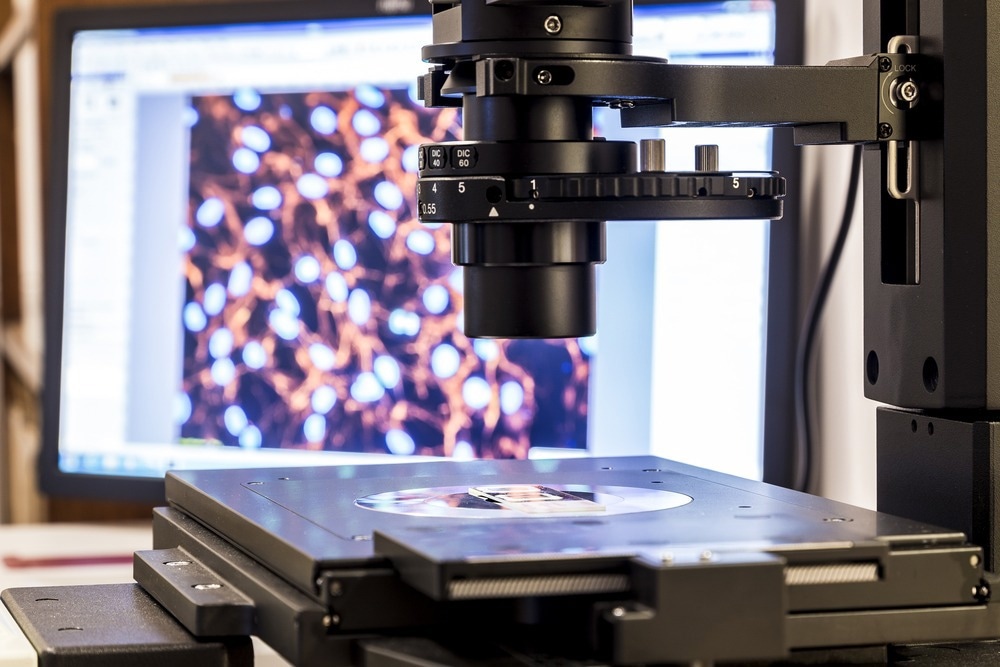The atomic force microscope (AFM) was introduced in 1986 to achieve high-resolution images of inorganic surfaces.

Image Credit: dominika zara/Shutterstock.com
The development of this advanced tool has led to further progressive applications for investigating biological systems, including using AFM for obtaining topographical images with a highly advanced resolution, such as a nanoscale resolution. This powerful microscope has been revolutionary for researchers that can probe and gain further biophysical and biomechanical information from samples for various fields.
How Does an Atomic Force Microscope Work?
AFM is a type of scanning probe microscope. It has a 3D positioning scanner that adjusts a tip’s position relative to the sample.
The probe or tip, connected to a flexible cantilever, scans the sample surface with a small repulsive force between the tip and sample. It is also possible for the tip to be in a fixed position with the sample being moved, referred to as a scanning sample. A detailed image can be generated through the deflection of a light beam as the tip is moved across the sample's surface.
How is Atomic Force Microscopy Used in the Nanotechnology Field?
Nanomaterials are particles with a minimum of one dimension comprising 100 nm or less, or nanoparticles, with at least two dimensions of 1-100 nm.
The high-resolution property of atomic force microscopes enables this powerful tool to be ideal for the characterization of nanoparticles and nanomaterials due to providing qualitative and quantitative data on a range of physical properties. These properties can include size, morphology, and surface texture, while providing statistical information such as surface area and volume distribution.
This surface analysis technique can be used with diverse sample types comprising thick film coatings, composites, glass, biological and synthetic membranes, biomaterials, and microorganisms.
The various sample types for AFM have led to novel approaches and perspectives in different fields, including nanotechnology, a versatile field that has aided in advancing many industries, from medicine, pharmaceuticals, electronics, and biomedical research.
An example of one such application can include the development of precision nanoparticles for drug delivery. Due to the small nano-scale size of nanoparticles, these engineered nanocarriers can bypass and navigate through biological barriers that would otherwise prevent large drug molecules from passing. The size of these particles can also ensure a natural interaction with biological systems, which can help target drugs towards a specific area of concern.
Advantages of Using Atomic Force Microscopy for Nanoparticle Characterization
The continuously evolving field of nanotechnology has led to the rapid growth of new nanomaterials that aim to advance various fields due to their unique physical and chemical properties at the nanoscale.
The Project on Engineering Nanotechnologies found that the inventory of nanotechnology-based products had grown by 621% between 2006 and 2011. The nanotechnology market value in 2017 was also reported to amount to approximately 49 billion dollars worldwide, and this growth has been predicted to progress exponentially.
With various nanomaterials and nanoparticles being researched for advancing the applications for nanotechnology in diverse industries, the use of AFM is integral. The characterization of different types of materials can aid in further advancing the field of nanotechnology, which is still progressing with limitations and challenges.
This can include research into optimizing the best material for an application, such as chitosan, a sustainable and biodegradable material that may be useful for interaction with biological systems within the body.
Other challenges and concerns can also include ensuring nanoparticles do not harm the environment, as the widespread use of nanotechnology-based consumer products may inevitably lead to waste. This can potentially lead to health and environmental risks that need to be mitigated by ensuring engineered nanoparticles are being characterized to the highest degree through AFM to assess the potential toxicity of these particles.
AFM can be advantageous for characterizing nanoparticles and nanomaterials within environmental samples, which can determine the particle size, chemical composition, and concentrations. This can be critical for assessing the natural interaction of nanoparticles and nanomaterials within the environment and ensuring nanotechnology-based products are biodegradable, sustainable, and non-toxic.
The Future of Using Atomic Force Microscopy for Characterizing Nanoparticles
Atomic force microscopy is a powerful surface analysis tool that can be used to provide high-resolution images and can be used to advance a diverse range of fields from medicine to electronics when applied to nanoparticles and nanomaterials.
The characterization of nanoparticles and nanomaterials can be a critical component of advancing the field of nanotechnology to ensure products have a high level of efficacy for a given purpose and be safe for both human and environmental health.
Research into optimization through surface characterization of these particles and materials can ensure particles are engineered with the most appropriate materials and elements for the highest benefit.
References and Further Reading
Farré M, Barceló D. (2012) Introduction to the Analysis and Risk of Nanomaterials in Environmental and Food Samples. Comprehensive Analytical Chemistry. 1-32. https://doi.org/10.1016/B978-0-444-56328-6.00001-3
Goss J, Volle C. (2019) Using Atomic Force Microscopy To Illuminate the Biophysical Properties of Microbes. ACS Appl Bio Mater. 3(1):143-155. https://doi.org/10.1021/acsabm.9b00973
Mitchell, M.J., Billingsley, M.M., Haley, R.M. et al. (2021) Engineering precision nanoparticles for drug delivery. Nat Rev Drug Discov 20, 101–124. https://doi.org/10.1038/s41573-020-0090-8
Torre B, Ricci D, Braga P. (2011) How the Atomic Force Microscope Works?. Methods in Molecular Biology. 3-18. https://doi.org/10.1007/978-1-61779-105-5_1
Disclaimer: The views expressed here are those of the author expressed in their private capacity and do not necessarily represent the views of AZoM.com Limited T/A AZoNetwork the owner and operator of this website. This disclaimer forms part of the Terms and conditions of use of this website.